It’s no secret that the water supply is constantly inundated with all sorts of waste and chemicals. Some are filtered out, others are not. Think about old, expired medicine you casually toss away. Pharmaceuticals don’t degrade.
“For specific compounds, like low concentrations of pharmaceuticals or hormones, that’s where our regular wastewater systems are not quite effective,” said Stacey Louie, assistant professor of civil and environmental engineering.
Follow the trail closely and you’ll see that the pills you toss end up on a trash heap, which disintegrates and leaches into the water system where it eventually faces the water filtration system. It’s a good system, but Louie thinks it can be better, especially in the field of light-reactive nanoparticles which have been proposed to remove trace chemicals from drinking water. Louie says there are some drawbacks to the process.
“One of the current limitations is that the nanoparticles now in use to break down pollutants only work under UV light, which consumes a lot of energy, so we’re trying to find new materials that work under sunlight,” said Louie.
Another problem is that the nanoparticles can quickly become coated with foulants (any substance that dirties or grimes the surface) in the water treatment process. “We’re investigating how these foulants change the effectiveness of the nanoparticles,” said Louie. The National Science Foundation has given Louie and Debora Rodrigues, associate professor of civil and environmental engineering, $300,000 to do both for their project, “Effects of surface-adsorbed biomolecules and geomolecules on the photoreactivity of metal oxide nanomaterials.”
Small particles, large impact
At water treatment plants, UV lamps activate nanoparticles, but Rodrigues and Louie are intent on modifying nanoparticles so the process will work under sunlight because, as Rodrigues says, “it’s cheaper.”
“You won’t have to plug in electricity and use a bulb or UV lamp,” said Rodrigues. But first they have to change the nanoparticles to activate and degrade the chemicals when exposed to sunlight. Rodrigues already pointed a research spotlight on this subject.
In her previous work Rodrigues identified and developed new nanomaterials that can degrade organic pollutants under sunlight irradiation. “This unique photoreactivity makes them attractive for applications in diverse water treatment technologies,” said Rodrigues.
In this research they will compare titanium dioxide, which is activated by ultraviolet light, to molybdenum oxide, a visible light-active nanomaterial that could show improved viability for water treatment applications. Louie and Rodrigues will further change the makeup of the materials by adding a coating to them to represent realistic water treatment scenarios. Along the way they will develop a model capable of predicting the effects of surface coatings on photoreactivity across a variety of materials.
“They are non-toxic,” said Rodrigues, who says the team would ultimately like to shine on several beams: Advancing the science of nanomaterials while at the same time finding alternative treatments that will be energy efficient and safe for humans.
That sounds like a ray of sunshine in the dark world of pollutants.
